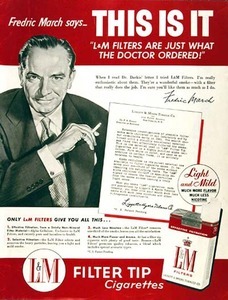Why Doctors Should Quit Being Involved in Smoking Cessation
 As part of my continuing efforts to keep up to date in the practice of medicine I subscribe to a generally very good online publication from America called, appropriately enough, UpToDate®. They send bi-weekly reminders of the latest research, and in today’s issue a section on e-cigarettes caught my eye. In America they are, rightly in my view, much less enthusiastic about these new nicotine delivery devices as a smoking cessation aid than in Britain, preferring the established orthodox medical approach.
As part of my continuing efforts to keep up to date in the practice of medicine I subscribe to a generally very good online publication from America called, appropriately enough, UpToDate®. They send bi-weekly reminders of the latest research, and in today’s issue a section on e-cigarettes caught my eye. In America they are, rightly in my view, much less enthusiastic about these new nicotine delivery devices as a smoking cessation aid than in Britain, preferring the established orthodox medical approach.
I’ll take just part from the extensive section on smoking cessation in the main publication.
Here is one way they suggest to get people to quit smoking:
The clinician can then engage the patient by asking whether the patient would like to quit. For example, ‘Quitting smoking can be hard, but there is good treatment and I can help you. Would you like to try?’
Note the discouraging implications that quitting is hard and treatment is needed.
Then it says:
Patients should be reminded of the addictive nature of smoking and that tobacco dependence should be treated as a chronic disease. In addition, the patient should be educated on the course of withdrawal symptoms, which typically peak one to two weeks after quitting but may continue for months. A fact sheet from the National Cancer Institute explains how to handle nicotine withdrawal symptoms and triggers.
I have already commented on the wrong-headed approach of the National Cancer Institute in my blog of 26 June 2016, How Not to Stop Smoking, Part II (https://www.nicotinemonkey.com/how-not-to-stop-smoking-part-ii)
Following the American tradition of never doing things by halves, there is even a section called Risks of Smoking Cessation:
Although the risks of smoking cessation are far outweighed by the benefits, these risks are important to address in order to maximize the likelihood that a patient will successfully quit tobacco use.
In the absence of nicotine, a smoker develops cravings for cigarettes and symptoms of the nicotine withdrawal syndrome. Symptoms generally peak in the first three days and subside over the next three to four weeks, but smokers’ cravings for cigarettes may persist for months to years. Nicotine withdrawal symptoms include:
Increased appetite or weight gain
Dysphoric, depressed mood, or anhedonia
Insomnia
Irritability, frustration, or anger
Anxiety
Difficulty concentrating
Restlessness
It’s predictable that they say the way to ‘respond if these symptoms occur’ is with ‘smoking cessation medications, including nicotine replacement therapy, bupropion, and varenicline [which] relieve the symptoms of nicotine withdrawal.’
What about the strange business of anhedonia? (From the Greek, meaning inability to feel pleasure.) ‘Results suggest that anhedonia is a unique and motivationally significant element of the tobacco withdrawal syndrome in humans.’ This is a quote from a cited paper from the February 2015 issue of the Journal of Abnormal Psychology (where else).
Let me set the record straight.
- There is no such thing as the tobacco withdrawal syndrome.
- Smoking is not a disease, chronic or otherwise, but a voluntary activity.
- The reason smoking seems hard to stop is because of nicotine addiction.
- The quoted withdrawal symptoms in UpToDate® and many other publications are nearly all grossly exaggerated or untrue.
- The orthodox approach to quitting is a result of the medical profession hijacking smoking and turning it into a disease.
- The last thing smokers want or need is to be given more nicotine or prescription drugs.
- Emphasis on the difficulties of quitting and awful withdrawals symptoms is discouraging, pointless, and counterproductive.
What doctors (apart from me) won’t tell you, is that quitting smoking can be easy.
You can learn about this approach here.
Text © Gabriel Symonds
